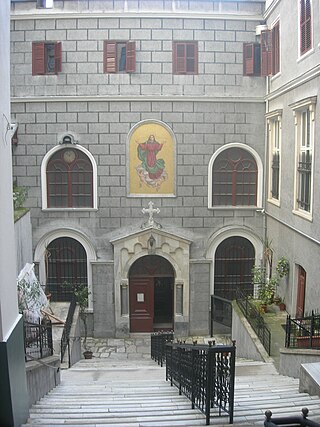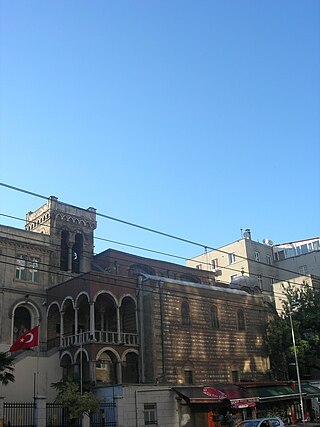
The Levant is an approximate historical geographical term referring to a large area in the Eastern Mediterranean region of West Asia. In its narrowest sense, which is in use today in archaeology and other cultural contexts, it is equivalent to Cyprus and a stretch of land bordering the Mediterranean Sea in western Asia: i.e. the historical region of Syria, which includes present-day Israel, Jordan, Lebanon, Syria, the Palestinian territories and most of Turkey southwest of the middle Euphrates. Its overwhelming characteristic is that it represents the land bridge between Africa and Eurasia. In its widest historical sense, the Levant included all of the Eastern Mediterranean with its islands; that is, it included all of the countries along the Eastern Mediterranean shores, extending from Greece in Southern Europe to Cyrenaica, Eastern Libya in Northern Africa.

İstiklal Avenue, historically known as the Grand Avenue of Pera, in the historic Beyoğlu (Pera) district, is an 1.4 kilometre (0.87 mi) pedestrian street and one of the most famous avenues in Istanbul, Turkey. It acquired its modern name after the declaration of the Republic on 29 October 1923, İstiklal (Independence) commemorating Turkey's triumph in its War of Independence.

Galata is the former name of the Karaköy neighbourhood in Istanbul, which is located at the northern shore of the Golden Horn. The district is connected to the historic Fatih district by several bridges that cross the Golden Horn, most notably the Galata Bridge. The medieval citadel of Galata was a colony of the Republic of Genoa between 1273 and 1453. The famous Galata Tower was built by the Genoese in 1348 at the northernmost and highest point of the citadel. Galata is now a quarter within the district of Beyoğlu in Istanbul.

Arap Mosque is a mosque in the Karaköy quarter of Istanbul, Turkey. The building was originally a Roman Catholic church erected in 1325 by the friars of the Dominican Order, near or above an earlier chapel dedicated to Saint Paul in 1233. Although the structure was altered during the Ottoman period, it is the only example of medieval religious Gothic architecture remaining in Istanbul.

Beyoğlu is a municipality and district of Istanbul Province, Turkey. Its area is 9 km2, and its population is 225,920 (2022). It is on the European side of Istanbul, Turkey, separated from the old city by the Golden Horn. It was known as the region of Pera surrounding the ancient coastal town Galata which faced Constantinople across the Horn. Beyoğlu continued to be named Pera during the Middle Ages and, in western languages, into the early 20th century.

The Catholic Church in Turkey is part of the worldwide Catholic Church, under the spiritual leadership of the Pope and the canonical leadership of the curia in Rome that is submitted to the Pope.

Antiochian Greek Christians are an ethnoreligious Eastern Christian group native to the Levant. They are either members of the Greek Orthodox Church of Antioch or the Melkite Greek Catholic Church, and they have ancient roots in what is now Syria, Lebanon, Palestine, Jordan, the southern Turkish province of Hatay, which includes the city of Antakya —one of the holiest cities in Eastern Christianity, and Israel. Many of their descendants now live in the global Near Eastern Christian diaspora. They primarily speak Levantine Arabic.

The Cathedral of the Holy Spirit, alternatively known as the St. Esprit Cathedral, located on Cumhuriyet Avenue 127/A, in the quarter of Pangaltı in Şişli district, the former Harbiye, between Taksim Square and Nişantaşı, is one of the main Catholic churches in Istanbul, Turkey. This 19th century cathedral is behind the walls of the French Notre Dame de Sion high school. While walking from Taksim towards Harbiye, some may notice a door with metal bars leading to the school's courtyard beyond which is a statue of Benedict XV. Past the door stands the cathedral.

Levantine mansions of İzmir refer to about thirty stately residences in İzmir, Turkey, dating principally from the 19th century and of which a significant number remain intact by being restored and continuing to be used and visited.

Karaköy, the modern name for the old Galata, is a commercial quarter in the Beyoğlu district of Istanbul, Turkey, located at the northern part of the Golden Horn mouth on the European side of Bosphorus.

The Church of St. Anthony of Padua, alternatively known as Sant'Antonio di Padova Church or S. Antonio di Padova, is the largest Catholic church in Istanbul, Turkey. It is located on İstiklal Avenue in the Beyoğlu district.

Religion in Istanbul covers the issue of religion in the city of Istanbul, Turkey. More than 90% of Istanbul's population are Sunni Muslims and Alevism forms the second biggest religious group. A 2019 survey study by KONDA that examined the religiosity of the voting-age adults in Istanbul showed that 47% of the surveyed had a religion and were trying to practise its requirements. This was followed by nonobservant people with 34% who identified with a religion but generally did not practise its requirements. 11% stated they were fully devoted to their religion, meanwhile 4% were non-believers who did not believe the rules and requirements of a religion and 4% were atheists who did not believe in religion at all. 24% of the surveyed also identified themselves as "religious conservatives".

Italy-Turkey relations are the relations between Italy and Turkey. Both countries are members of NATO and the Union for the Mediterranean and have active diplomatic relations. Relations between Turkey and Italy date back centuries in the form of various predecessor states.
Giovanni Scognamillo was a Turkish Levantine film critic.

SS Peter and Paul is a Catholic church in Istanbul, important for historical reasons. The church owns an icon of the Virgin of the Hodegetria type, which originally lay in a Dominican church in Caffa, Crimea. The current building is a nineteenth-century reconstruction of the Fossati brothers. An adjacent former commercial facility, Saint Pierre Han, is set to be renovated into a cultural center.

The Genoesecolonies were a series of economic and trade posts in the Mediterranean and Black Seas. Some of them had been established directly under the patronage of the republican authorities to support the economy of the local merchants, while others originated as feudal possessions of Genoese nobles, or had been founded by powerful private institutions, such as the Bank of Saint George.

Pangaltı Roman Catholic Cemetery, also known as Feriköy Latin Catholic Cemetery, is a historic Christian cemetery in Istanbul, Turkey. It is the largest Catholic cemetery in Istanbul. The cemetery is located in the Feriköy neighborhood of the Şişli district, nearly 3 km (1.9 mi) north of Taksim Square. The main Protestant burial ground of the city; Feriköy Protestant Cemetery, Istanbul lies immediately across the Catholic cemetery. The two neighboring cemeteries are divided by the Abide-i Hürriyet Avenue.

Saint Mary Draperis is a Catholic church in Istanbul, important for historical reasons. Established in 1584, the church is one of the most ancient Catholic parishes of Istanbul.

Saint Benoit is a Roman Catholic Church in Istanbul, Turkey, important for historical reasons. Established in 1427, the shrine is the oldest Catholic church of Istanbul still in use.

Levantines in Turkey or Turkish Levantines, refers to the descendants of Europeans who settled in the coastal cities of the Ottoman Empire to trade, especially after the Tanzimat era. Their estimated population today is around 1,000. They mainly reside in Istanbul, İzmir and Mersin. Anatolian Muslims called Levantines Frenk and tatlısu Frengi in addition to Levanten. Turkish Levantines are mostly Latin Catholics.


























